|
Test Drive: 2009 BMW 328i xDrive
Manufacturer’s web site |
By Chris Chase
Top photo by Laurance Yap
Most reviews of the BMW 3 Series include two things: a reference by the reviewer to the car being the most desirable in its class, and comments from readers that BMW must be paying auto writers for so many unanimously positive opinions of the car.
BMW must be paying 3 Series buyers too, then, because the car is perennially a strong seller in Canada. In 2010, 14,009 Canadians bought 3 Series’, which made it the most popular luxury car and put it in the same league, sales-wise, as the Honda Accord (14,659 sales in 2010) and the Chevrolet Malibu (13,092 sales).
For 2006, BMW introduced the fifth generation (E90, for those who follow BMW’s model codes, references the sedan, while the wagon, coupe and convertible are known as the E91, E92 and E93, respectively) of its most popular model, wearing controversial styling that many thought would allow a car like the Infiniti G35 – a car that comes close to matching the 3 Series’ excellent driving characteristics – to overtake it in the sales race. In retrospect – yeah, right.
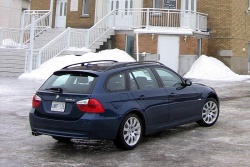 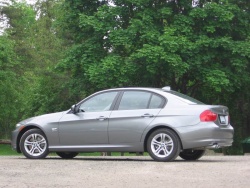 2006 BMW 325xi Touring (top); 2009 BMW 328i xDrive. Photos by Chris Chase. Click image to enlarge |
The E90 3 Series arrived in sedan and wagon (Touring) variants for its first year, available as the 323i, 325i and 330i in the sedan. The 323i used a 2.5-litre engine making 174 horsepower, while the 325i and 330i shared a 3.0-litre motor tuned for 215 hp in the 325i and 255 hp in the 330i.
The 325xi and 330xi were all-wheel drive models; the wagon was sold only in 325xi form. Coupe, convertible and the high-po M3 were carried over from 2005.
The 2007 line-up got new names and restyled coupe and convertible models. The 323i’s 2.5-litre engine now made 200 hp, while the newly-named 328i got a 230-hp 3.0-litre engine and the 335i used a new turbocharged motor with 300 hp. For this year, just the 328i could be optioned with all-wheel drive (again, this is the only way the wagon was offered); the coupe was available in 328i (RWD or AWD) or 335i versions, and the convertible – with its all-new folding hardtop – was sold as the 328i and 335i, but in RWD only.
In 2008, BMW added an AWD option to the 335i model, in sedan or coupe form. All 2006 through 2008 3 Series models came standard with a six-speed manual transmission that could be optioned to a six-speed automatic. The M3 made its triumphant return to the 3 Series line, complete with a 414-hp V8 in place of the old version’s in-line six; a seven-speed dual-clutch transmission was the option to the standard six-speed manual.
New in 2009 was the 335d with its smooth, torque-rich diesel engine. It was offered only with a six-speed automatic. In addition, BMW dropped the “x” from AWD variants’ names, instead dubbing these cars 328i/335i xDrive.
Changes for 2010 were mostly in trim, with most models getting additional standard equipment: 17-inch wheels on the 328i, and sport suspension and heated steering wheel were added to the 335i, for examples.
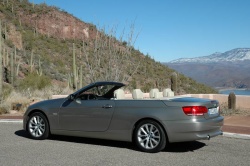 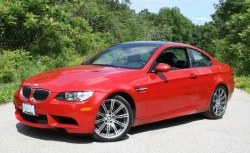 2007 BMW 3 Series cabriolet (top), by Paul Williams; 2008 BMW M3, by Grant Yoxon. Click image to enlarge |
In 2011, coupe and convertible models got a styling update, while the 335i got a new turbocharged engine (power output was unchanged) and a 335is trim was added to the coupe and convertible, and included an uprated version of the new turbo motor, with 320 hp. These cars also got a great-sounding sport exhaust system, aerodynamics package and interior trim upgrades.
Despite the rather extensive range of engines offered in the 3 Series, few offer any significant fuel economy advantages. Aside from the M3, gas-powered 3 Series’ Natural Resources Canada consumption ratings are in a range from 11 to 12.5 L/100 km in city driving, and 6.7 to 8 L/100 km in the highway cycle; generally, the bigger engines use more fuel, as do all-wheel drive cars. The M3 is rated 15.3/9.7 (city/highway) with a stickshift, and changes little with the dual-clutch option. Going diesel in a 2009 or newer model gets you the best ratings, at 9.0/5.4 L/100 km, which puts the 335d in the same league as a four-cylinder family sedan, but with way more power.
Consumer Reports (CR) pegs the E92 3 Series’ reliability anywhere from “much worse than average” to “better than average,” a variance that can be attributed to the car’s wide range of powertrain options.
One well-documented problem is that of a failure-prone high pressure fuel pump in turbocharged cars, characterized by long crank times, rough idle and rough running and stalling at wider throttle openings; read about it here and here. That issue alone is enough to drive the 335i’s reliability into the below-average range, while non-turbo cars enjoy more favourable ratings. The turbocharged six-cylinder is also known for problems with the VANOS variable valve timing system. BMW has issued a technical service bulletin to look after this. A helpful reader pointed out that BMW Canada has offered extended emissions system warranty coverage to 10 years km for Canadian owners of 2008-2009 model cars with the turbocharged engine.
CR notes widespread “minor” engine problems in 2006 models with the 3.0-litre engine (325i and 330i); this could be related to the matter of ticking valvetrains, as discussed here. CR also indicates that engine cooling system problems – radiators, thermostats, water pumps and coolant leaks – prevalent in the previous generation car – also affect the E90 series.
If the user-reported data at TrueDelta.com is an indication, the non-turbo six-cylinder engines are the more reliable choice in this generation of 3 Series; most of the complaints logged there related to engine troubles with the turbocharged six.
Click here for a handy thread listing Technical Service Bulletins that have been issued for E90 series cars.
A 3 Series whose steering makes a clicking/ticking sound, or feels loose when the steering wheel is turned might have this problem with the steering input shaft.
To get an idea of what problems a small sample of 3 Series owners have had, browse this thread at E90Post.com, or this similar one at BimmerForums.com.
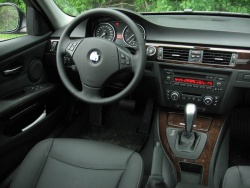 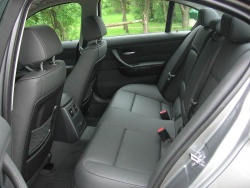 2009 BMW 328i xDrive; photos by Chris Chase. Click image to enlarge |
It’s common for a 3 Series to refuse to start in order to avoid the risk of the steering wheel locking up while driving.
BimmerForums.com has a section dedicated to DIY maintenance and repair procedures.
CR notes a few other trouble spots, including, in its words, door locks/latches and power windows.
Crash safety rates high, with “good” results in the Insurance Institute for Highway Safety’s (IIHS) frontal offset and side crash tests, and four and five stars in National Highway Highway Traffic Safety Administration (NHTSA) frontal and side impact tests.
Unless you think fun is stupid or would rather take the bus, it’s next to impossible not to like the 3 Series. Even the most basic models, with their only-adequately-powerful engines, are satisfying cars to tear along a twisty road in, especially with a manual transmission. Keep in mind that even a reliable BMW will be a more expensive car to maintain than any mainstream mid-sized car, but if you love to drive, the extra cost will be worth it. Much as it pains me to say it, if you like reliability, avoid the turbocharged 335i models and their troublesome fuel pumps, and approach the diesel-powered 335d with caution, only because not much is known about that motor’s reliability yet; otherwise, a car that comes with complete service records and passes a mechanic’s inspection (try for a shop that knows BMWs and their quirks) will be as good a deal as you’re likely to get on one of the best all-around cars the used market has to offer.











